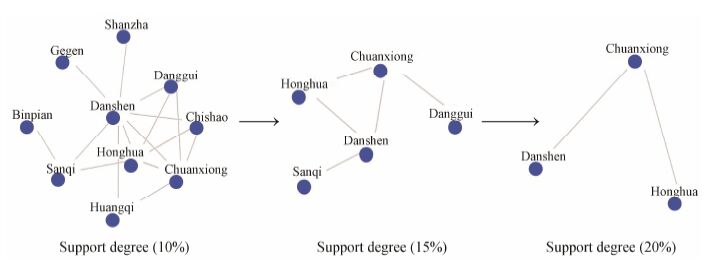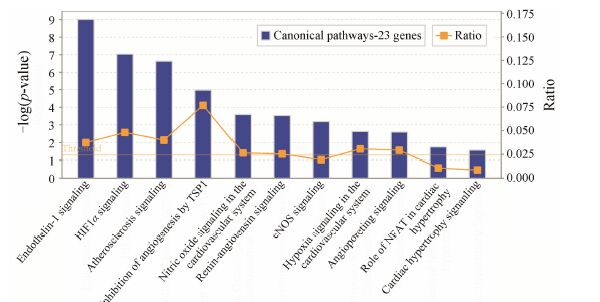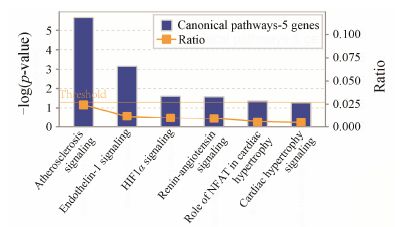2. 天津国际生物医药联合研究院中药新药研发中心, 天津 300457
2. Tianjin International Joint Academy of Biomedicine, Tianjin 300457, China
以通利血脉、促进血行和消散淤血为主要功效,用于治疗淤血病证的药物,称为活血化瘀药[1]。活血化瘀中成药 (promoting blood circulation and removing blood stasis,PBCRBS) 临床上常用于心脑血管相关疾病,具有抗血栓、抗凝血及防治动脉硬化斑块形成等作用,尤其在抗血栓方面,具有显著疗效。与抗血栓西药相比,活血化瘀中药尽管抗血栓作用平和,但具有多途径、多靶点且不良反应少等优点[2]。目前,活血化瘀中成药的应用十分广泛,具有很好的疗效,但因种类繁多、成分复杂,其协同配伍机制尚不明确。另外,与西药相比,中成药功能主治的描述普遍缺乏精准的适应证表述,制约了其临床的有效和安全应用。因此,运用简便有效的研究思路,分析活血化瘀中成药配伍规律及其协同配伍抗血栓作用机制甚为有益。
材料与方法 方剂和单体收集方剂主要来源于药源网、找 药网及《中国药典》[3]和其他参考文献[4, 5, 6, 7, 8, 9]。遴选原则: ① 药品说明书功效主治中含有“活血化瘀”或“抗血栓”相关字样。② 经国家食品药品监督管理总局 (CFDA) 网站查询,具有“国药准字Z****”批准文号。③ 药品主要成分为2味或2味以上中药复方。④ 成分相同、剂型不同的方剂按一个品种统计。单体主要通过TCMSP[10]、TCMID、TCM-ID[11]和TCMDataba se@Taiwan[12]等数据库查询整理,结合PubChem[13]和eMolecules数据库查询单体对应的CID或CAS号,建立中药单体数据源。
信息录入将上述遴选出的方剂经专人分类整理后,输入中医传承辅助平台 (TICMISS,V2.0)[14],由双人负责校准,确保数据的准确性。将建立的中药单体数据导入ingenuity pathway analysis (IPA) 中,IPA通过单体的CID或CAS号识别数据。
分析方法方剂分析: 使用中医传承辅助系统“方剂优化分析”功能,对活血化瘀中成药进行显性和隐性配伍规律分析。靶点分析: 以血栓 (thrombosis) 为模型进行检索,得到相关分子靶点197个,设为集合A; IPA识别的中药单体共计128 个 (丹参33个、红花47个和川芎48个) 设为集合B,二者进行“Path Explorer”作用关系分析。用“molecule activity predictor (MAP)”功能预测单体对分子的上调或下调作用[15]。用“core analysis”功能对作用靶点及相关通路信息进行总结分析[16]。
结果 1 活血化瘀中成药单味药频次统计收集到的224种活血化瘀类中成药,其中含320味中药。频次统计 (频次≥10) 结果显示,35个常用中药中,配伍使用最多的3味药依次为丹参、川芎和红花,见表 1。
|
|
Table 1 Frequency of herbs in the Chinese traditional patent medicine for promoting blood circulation and removing blood stasis (PBCRBS) (frequency ≥ 10) |
活血化瘀组方配伍规律结果显示,3味药配伍使用最多的是丹参、川芎和红花,见表 2。设置支持度22、置信度0.9,进行关联规则分析。结果显示,在活血化瘀中药中,当含有丹参和红花时,川芎出现的概率约为94%,进一步说明3味药的配伍使用频繁,见表 3。同时含有这3味药的代表中成药有: 丹芎通脉颗粒、精制冠心片、乐脉颗粒、丹红化瘀口服液和血必净注射液等。配伍使用最多的药对: 丹参和川芎,代表方剂为通脉口服液; 川芎和红花,代表方剂为脑得生胶囊; 三七和丹参,代表方剂为三七丹参片; 丹参和红花,代表方剂为丹红注射液。
|
|
Table 2 Core combinations with high frequency mined from PBCRBS formulae (support number: 22,confidence ≥ 0.9) |
|
|
Table 3 Association rule of PBCRBS formulae (support number: 15,confidence ≥ 0.85) |
设置不同的支持度,对活血化瘀中成药核心药物组合进行深度分析。结果显示,随着支持度的增加,既能体现不同药物组合间的个性特征,又能突显药物间的核心组合。在支持度为20% 时,可以明显看到丹参、川芎和红 花三者之间在活血化瘀中成药中核心配伍关系; 随着支持度的递减,除上述3味活血化瘀药外,一些清热、补气、补血和开窍等药物的配伍得到体现,见图 1。

|
Figure 1 Network on core combinations in depth of PBCRBS formulae (support degree: 10%,15%,20%,confidence ≥ 0.9) |
通过上述中医传承辅助平台对活血化瘀中成药的数据挖掘分析,无论在用药频率还是药物的核心组合方面,丹参、川芎和红花的作用得以凸显,但其协同配伍作用机制尚不清楚。通过IPA的“Path Explorer”分析和“MAP”预测功能,总结含丹参、川芎和红花活血化瘀中成药的协同配伍抗血栓作用机制。结果得到丹参 (9个)、川芎 (4个) 和红花 (8个) 所含活性成分 (25个) 之间协同配伍与血栓相关分子 (29个) 的作用关系及对分子靶点的上调、下调作用,其中6个分子上调,19个分子下调,4个分子双向调节,见图 2。

|
Figure 2 Analysis network of collaborative compatibility of anti-thrombotic mechanism of Danshen,Chuanxiong and Honghua |
通过IPA的“core analysis”功能对丹参、川芎和红花可调控的29个血栓相关分子进行深度分析。结果显示,29个血栓相关分子中有23个分子与炎症反应有关,如图 3。由IPA的“canonical pathways”功能分析得知,23个炎症反应相关分子涉及到的通路较多,重点选择与心血管 (cardiovascular) 疾病相关的通路进行分析,并按照涉及的分子个数多少排序 (−Log p-value为柱 高,代表通路相关性; ratio代表分子个数与通路分子总数的比值),相关性较高的为endothelin-1 signaling、HIF1α signaling和atherosclerosis signaling,如图 4。根据所得结果提示的信息,进一步对丹参、川芎、红花与29个分子的相关程度进行总结,分析其潜在的协同配伍机制。得到3味活血化瘀中药所含单体与NOS2 (受13个单体调节)、PTGS2 (受11个单体协同调节) 2个炎症相关分子及IL-6 (受9个单体协同调节)、TNF (受9个单体协同调节)、IL-1 β (受6个单体协同调节) 3个炎症因子关系最为密切,并且对这5个分子的作用关系均为下调。5个炎症相关分子涉及的经典通路相关性最高的为atherosclerosis signaling,见图 5。3味中药所含单体和5个炎症相关分子的详细信息,见表 4。由上述基于IPA的深度分析显示,炎症反应与血栓形成的关系十分密切。通过对炎症与血栓关系的相关文献[17, 18, 19, 20, 21]整理得知,抗炎治疗可以抑制血栓的形成,抗血栓治疗又可以抑制炎症反应; 炎症诱导的静脉血栓甚至在血管未损伤的情况下仍能形成。同时,丹参[22, 23]、川芎[24, 25]和红花[26, 27]3味中药不但具有较好的抗血栓作用,而且抗炎效果显著。

|
Figure 3 The relationship between inflammatory response and thrombosis |

|
Figure 4 23 genes of inflammatory response related cardiovascular canonical pathways (−Log p-value: the relevance of the molecules and pathways,ratio: molecules number / total molecules number of pathway) |

|
Figure 5 5 important genes of inflammatory response related cardiovascular canonical pathways(−Log p-value: the relevance of the molecules and pathways,ratio: molecules number / total molecules number of pathway) |
|
|
Table 4 The relationship between Danshen,Chuanxiong,Honghua ingredients and molecules related to thrombosis |
3味中药在方剂配伍中,多以君药或臣药与其他药物配伍使用,在治疗血栓相关疾病中起核心作用,具有显著的临床疗效。由此推测,含丹参、川芎和红花活血化瘀中成药的抗血栓作用主要与其抑制炎症反应有关。
讨论剖析中成药治疗疾病的协同配伍作用机制是当今中药研究的热点和难点。网络药理学为药物多成分、多靶点的研究与分析提供了很好的平台[28, 29]。李慧颖等[30]使用网络药理学的方法,通过网络数据库整理、建立计算模型、预测作用靶点等途径分析了中成药葛根芩连汤抗2型糖尿病的可能作用网络,具有很好的借鉴和指导意义。中医传承辅助系统和IPA软件的结合使用,能够在挖掘中成药配伍规律的基础上,分析药物协同配伍与靶点的作用关系。不但为后续的研究提供了一个相对简易的分析研究方法,而且对阐明中成药的物质基础和作用机制也具有较大意义。在今后的临床用药和活血化瘀中成药的研发中,根据临床适应证,可以考虑与丹参、川芎和红花中的单味或多味药配伍使用,或许会达到更好的临床疗效。
活血化瘀中成药功效主治多以血瘀证和血栓相关疾病等为主。因此,本文选用血栓为模型,研究活血化瘀中成药的抗血栓作用机制。血栓相关疾病包括心肌梗死、脑梗死和肺栓塞,组织器官缺血、坏死等,严重威胁人体健康。炎症反应是很多疾病引发的源头并伴随疾病的整个过程。炎症可诱导内皮损伤,从而导致生理抗凝剂的缺失,血管舒张功能减弱; 炎症还可以增加促凝因子的释放,抑制溶解纤维蛋白的活性,从而促进血栓形成[17]。虽然,在过去一个多世纪,血小板作为血栓与止血的中枢介质一直是血小板生物学的研究重点,但近10年中,大量的实验证据表明血小板除止血功能外,在介导多种炎症、免疫和恶性疾病的过程中也起着关键作用。抗血栓和抗炎药物的联合使用已成为心血管药物研发的热点之一[31]。
本研究创新点在于: ① 近年诸多学者[32, 33]使用中医传承辅助平台分析治疗一些疾病的组方规律或含一些指定中药的用药规律,前期的工作对指导方剂的配伍使用有较好的参考性。本文在此基础上,结合TCMSP、TCM-ID、PubChem和eMolecules等一些现代的生物信息学方法,并通过IPA特有的靶点 分析功能,为后续活血化瘀中成药协同配伍抗血栓作用机制研究提供了一定的参考价值。② 本文选择的分析对象为市售活血化瘀类中成药,患者易遵医嘱选择购买,分析其配伍规律具有很好的现实意义。③ 通过中医传承辅助系统和IPA等生物信息方法的联合应用,形成了从宏观到微观、从临床应用到生物学本质的研究思路,为中药的协同配伍作用机制研究提供依据。本研究局限性: ① IPA收录标准为影响因子大于3的期刊文献,因此可能会造成一些有效单体数据的遗漏,但在一定程度上也确保了数据的准确性。② 本文所得结论需要临床和实验进一步验证分析。
综上所述,丹参、川芎和红花3味中药在活血化瘀中成药中配伍使用最为频繁。含丹参、川芎和红花活血化瘀中成药的抗血栓作用,主要与其抑制炎症反应有关。抑制炎症相关分子NOS2、PTGS2、IL-6、TNF和IL-1β及其相关通路,在今后含丹参、川芎和红花活血化瘀中成药抗血栓作用机制的研究中应得以重视和关注。
| [1] | Gao XM. Chinese Material Medica (中药学) [M]. 2nd ed. Beijing: Chinese Press of Traditional Chinese Medicine, 2007: 311. |
| [2] | Xia M, Chen XH. The antithrombotic effect research progress of traditional Chinese medicine for promoting blood circulation and removing blood stasis [J]. Guide J Tradit Chin Med (中医药导报), 2012, 18: 83−84, 87. |
| [3] | Chinese Pharmacopoeia Commission. Pharmacopoeia of the People’s Republic of China (中华人民共和国药典) [S]. Part I. 2010 ed. Beijing: China Medical Science Press, 2010. |
| [4] | Wu SJ. The rational use of traditional Chinese medicine for promoting blood circulation and removing blood stasis [J]. Strait Pharm J (海峡药学), 2013, 25: 235−237. |
| [5] | Wang QL. Prescription rule research of 117 kinds of hyperlipidemia Chinese patent medicine [J]. Chin Tradit Pat Med (中成药), 2013, 35: 1107−1109. |
| [6] | Qian ZG, Wang CJ, Chen WL. Utilization of Chinese herbal pieces in Shanghai eighth people’s hospital during 2010−2012 [J]. Eval Anal Drug Use Hosp China (中国医院用药评价与分析), 2013, 13: 871−873. |
| [7] | Chen T, Ni ML, Ding Y, et al. Analysis on use of activating blood and resolving blood stasis Chinese patent medicines in Shanghai 2013 [J]. J Liaoning Univ Tradit Clin Med (辽宁中医药大学学报), 2014, 16: 195−197. |
| [8] | Ma YG, Shao M. Analysis of the application of chinese patent medicines for activating blood circulation and dissipating blood stasis in our hospital during 2010-2012 [J]. China Pharm (中国药房), 2014, 25: 1791-1793. |
| [9] | Fei YM. Application of Chinese patent medicines of activating blood circulation to dissipate blood stasis in our hospital in 2007-2009 [J]. Chin J Clin Rational Drug Use (临床合理用药杂志), 2010, 3: 54-55. |
| [10] | Ru JL, Li P, Wang JN, et al. TCMSP: a database of systems pharmacology for drug discovery from herbal medicines [J]. J Cheminformatics, 2014, 6: 1-6. |
| [11] | Chen X, Zhou H, Liu YB, et al. Database of traditional Chinese medicine and its application to studies of mechanism and to prescription validation [J]. Brit J Pharmacol, 2006, 149: 1092-1103. |
| [12] | Chen CY. TCM Database@Taiwan: the world’s largest traditional Chinese medicine database for drug screening in silico [J]. PLoS One, 2011, 6: e15939. |
| [13] | Bolton EE, Wang YL, Thiessen PA, et al. PubChem: Inte-grated Platform of Small Molecules and Biological Activities [M]// Wheeler RA, David C. Annual Reports in Computational Chemistry. Elsevier Science Ltd, 2008: 217-241. |
| [14] | Lu P, Li J, Tang SH, et al. Development and application of traditional Chinese medicine inheritance support system [J]. Chin J Exp Tradit Med Form (中国实验方剂学杂志), 2012, 18: 1-4. |
| [15] | Rasmussen AL, Okumura A, Ferris MT, et al. Host genetic diversity enables Ebola hemorrhagic fever pathogenesis and resistance [J]. Science, 2014, 346: 987-991. |
| [16] | Liang F, Li L, Wang ML, et al. Molecular network and chemical fragment-based characteristics of medicinal herbs with cold and hot properties from Chinese medicine [J]. J Ethnopharmacol, 2013, 148: 770-779. |
| [17] | Aksu K, Donmez A, Keser G Inflammation-induced thrombosis: mechanisms, disease associations and management [J]. Curr Pharm Des, 2012, 18: 1478−1493. |
| [18] | Samad F, Ruf W. Inflammation, obesity and thrombosis [J]. Blood, 2013, 122: 3415-3422. |
| [19] | Nagareddy P, Smyth SS. Inflammation and thrombosis in cardiovascular disease [J]. Curr Opin Hematol, 2013, 20: 457-463. |
| [20] | Rodriguez AL, Wojcik BM, Wrobleski SK, et al. Statins, inflammation and deep vein thrombosis: a systematic review [J]. J Thromb Thrombolys, 2012, 33: 371-382. |
| [21] | Libby P, Simon DI. Inflammation and thrombosis: the clot thickens [J]. Circulation, 2001, 103: 1718-1720. |
| [22] | Stumpf C, Fan QL, Hintermann C, et al. Anti-inflammatory effects of danshen on human vascular endothelial cells in culture [J]. Am J Chin Med, 2013, 41: 1065-1077. |
| [23] | Su CY, Ming QL, Rahman K, et al. Salvia miltiorrhiza: traditional medicinal uses, chemistry, and pharmacology [J]. Chin J Nat Med, 2015, 13: 163-182. |
| [24] | Or CT, Yang LH, Law HY, et al. Isolation and identification of anti-inflammatory constituents from Ligusticum chuanxiong and their underlying mechanisms of action on microglia [J]. Neuropharmacology, 2011, 60: 823-831. |
| [25] | Jin YQ, Hong YL, Li JR, et al. Advancements in the chemical constituents and pharmacological effects of Chuanxiong [J]. Pharm Clin Chin Mater Med (中药与临床), 2013, 4: 44-48. |
| [26] | Asgarpanah J, Kazemivash N. Phytochemistry, pharmacology and medicinal properties of Carthamus tinctorius L [J]. Chin J Integr Med, 2013, 19: 153-159. |
| [27] | Xu SX. Anti-inflammatory active constituents of Cartha-mus tinctorius (2) [J]. Chin J Chin Meter Med (中国中药杂志), 1986, 11: 42−44. |
| [28] | Cheng BF, Hou YY, Jiang M, et al. Anti-inflammatory mechanism of Qingfei Xiaoyan Wan studied with network pharmacology [J]. Acta Pharm Sin (药学学报), 2013, 48: 686-693. |
| [29] | Liu AL, Du GH. Network pharmacology: new guidelines for drug discovery [J]. Acta Pharm Sin (药学学报), 2010, 45: 1472-1477. |
| [30] | Li HY, Zhao LH, Zhang B, et al. A network pharmacology approach to determine active compounds and action mechanisms of Ge-Gen-Qin-Lian decoction for treatment of type 2 diabetes [J]. Evid Based Compl Alt Med, 2014, 2014: 495840. |
| [31] | Mcfadyen JD, Kaplan ZS. Platelets are not just for clots [J]. Transfus Med Rev, 2015, 29: 110-119. |
| [32] | Zong X, Ji XM, Wei FQ, et al. Analysis on prescription rules of treating senile dementia based on traditional Chinese medicine inheritance auxiliary systems [J]. Chin J Chin Mater Med (中国中药杂志), 2014, 39: 640-643. |
| [33] | Wu JR, Guo WX, Zhang XM, et al. Analysis on principle of treatment of cough of Yan Zhenghua based on apriori and clustering algorithm [J]. Chin J Chin Mater Med (中国中药杂志), 2014, 39: 623-626. |
 2015, Vol. 50
2015, Vol. 50


